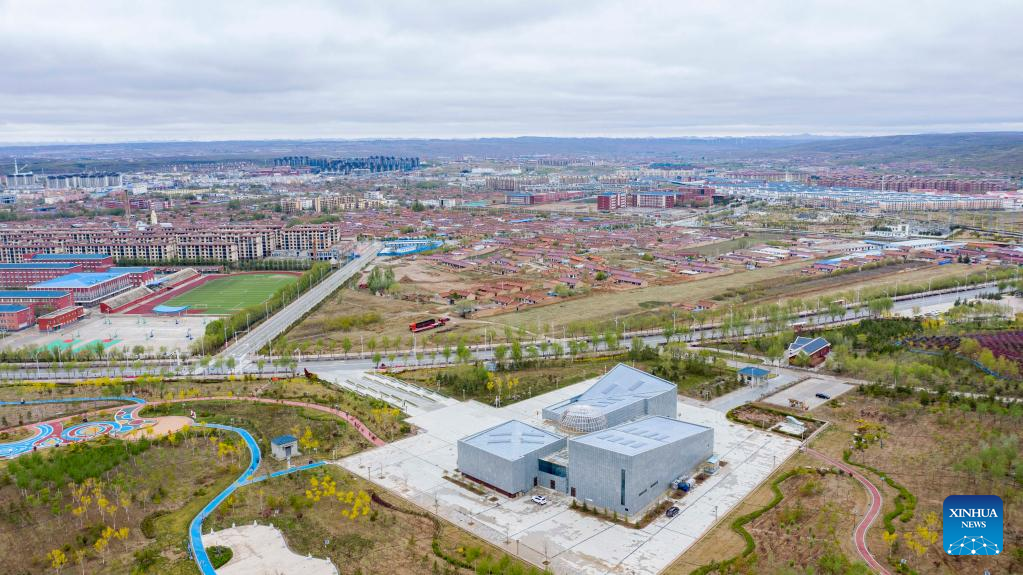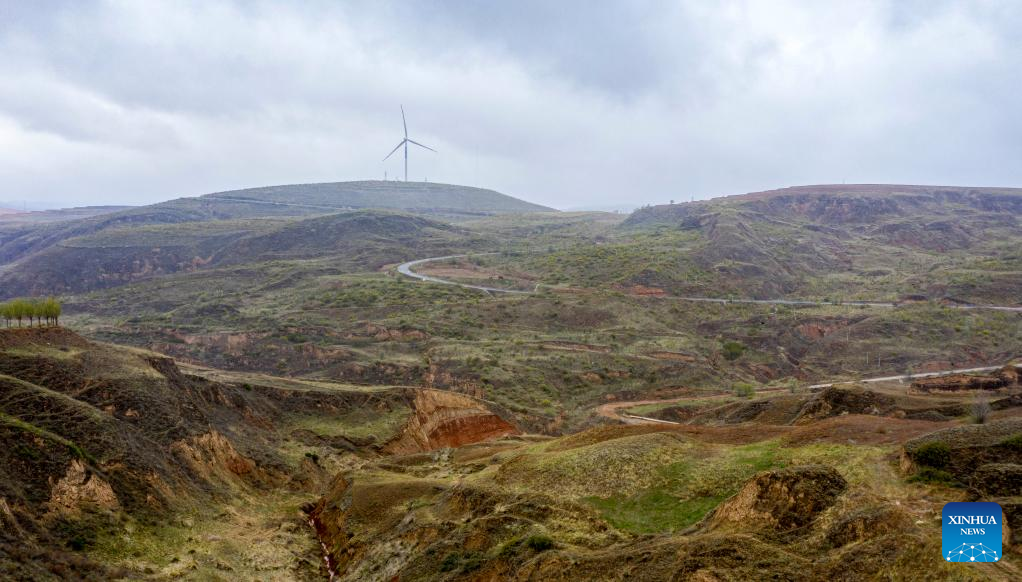
This aerial photo taken on May 9, 2023 shows the scenery of Haiyuan County, Zhongwei City, northwest China's Ningxia Hui Autonomous Region. (Xinhua/Yang Zhisen)
YINCHUAN, May 12 (Xinhua) -- In a village 30 km from the county seat of Haiyuan, northwest China's Ningxia Hui Autonomous Region, a willow tree with a V-shaped trunk stands on a hill as witness to a devastating earthquake over a century ago.
On Dec. 16, 1920, an 8.5-magnitude quake ripped through dozens of counties in northwest China, with Haiyuan at the epicenter. The earthquake claimed the lives of over 270,000 people, making it one of the deadliest in the 20th century. This tragic event was recorded by almost 100 seismic monitoring stations across the globe.
Located right on the rupture caused by the quake, the trunk of the willow tree had a deep split down the middle. However, the tree has miraculously survived and thrived.
"The tree is still sprouting, like telling people there is always hope for a better life," said Zhao Tinghu, deputy director of the seismological bureau of Haiyuan.
With a height of 13 meters and covered by a luxuriant crown of over 10 meters in diameter, the tree, which is about 500 years old, has come to be known as "zhenliu," or "earthquake willow," due to its extraordinary experience.
May 12 marks China's national day for disaster prevention and relief, which was established in 2009 to commemorate the 2008 Wenchuan earthquake that left more than 80,000 people dead or missing.
Haiyuan has been a destination for seismologists and historians to conduct research with some well-protected remains from 1920. In 2010, an earthquake museum opened in the county with a displayed collection of pictures, printed articles, and old-time objects that recount the disaster. The museum receives hundreds of thousands of visitors each year.
"The earthquake in Haiyuan reminds people of the importance of always standing prepared and alert for natural disasters. This is done through conducting scientific research, emergency relief preparations, spreading relevant knowledge and establishing a modern mechanism for disaster relief," said Zhao.
The local seismological bureau regularly holds training sessions and educational events to enhance public awareness of disaster prevention and increase self and mutual-rescue skills.
Having weathered over 100 years of vicissitudes after the quake, the willow has also borne witness to the changes in China's rural life.
Haiyuan is situated in Xihaigu, a region crossing the central and southern parts of Ningxia that was once deemed uninhabitable. In 2020, Haiyuan was lifted from absolute poverty, and the county is experiencing rapid revitalization with cattle breeding as its pillar industry.
One can see an exhibition of cows and bulls from all over the world at the "Bull King Valley" in the county, a major beef cattle breeding and production center covering an area of 400 hectares.
"We have a long tradition of cattle raising here. Now we have bought the world's best breeds to create a quality local stock," said Chen Liwen, a staff member at the base.
Ha Peng, a 23-year-old college student majoring in chemistry, returns home during the holidays to help his family on their cattle farm near the base.
"Last year we bought 20 cows and five calves with a low-interest loan of 200,000 yuan (about 28,780 U.S. dollars) provided by the local government. If all goes well, in three years, we will have five newborns, and the total value of my cattle will be around 250,000 yuan," Ha said.
In the Guanqiao Township of Haiyuan, villagers have built a modernized residential area called "Hope Town" with villa-like two-storey houses in it. Small shops have lined up a main street inside and spare rooms are ready for rent to tourists, helping villagers earn more money.
"We have several schools, a kindergarten, a hospital and a small museum on the local revolutionary history in the 1930s. I think we are living a life not so different from in the cities," local villager Feng Zenghu said proudly. ■

This aerial photo taken on May 9, 2023 shows landslides created by an earthquake over a century ago in Haiyuan County, Zhongwei City, northwest China's Ningxia Hui Autonomous Region. (Xinhua/Yang Zhisen)



